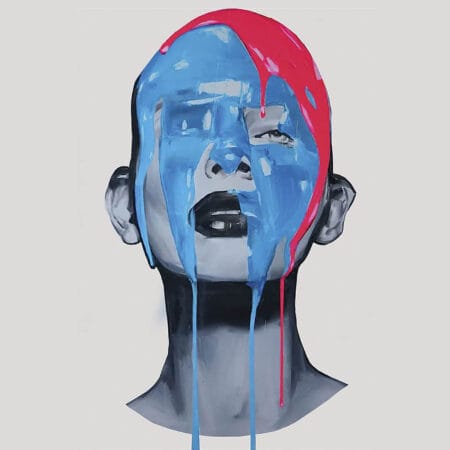The term “pre -march” describes a period of time in German history and culture, which extends from the years after the Vienna Congress in 1815 until the outbreak of the March Revolution in 1848. Art historians take this German history era closer - between the July Revolution of 1830 and the March Revolution.
It was a time of the political and social upheaval in which the demand for more freedom and equality became more and more louder.

These demands were reflected not only in the political movements and debates of the time, but also in art and literature .
Meaning in German history
The epoch of the Vormärz is closely linked to political developments in Germany and Europe. After the Napoleonic wars and the fall of Napoleon, the major European powers came together at the Vienna Congress to redesign the political order in Europe.
This led to a restoration of the old monarchical order and oppression of liberal and national movements. But despite the repressive measures, the desire for political participation and national unity in Germany grew.
Art and literature in the Vormärz
The art and literature of the Vormärz period reflect the political and social tensions of the time. Artists and writers used their works to express their dissatisfaction with the existing order and to share their visions for a better future.
They criticized the social grievances, denounced political oppression and dreamed of a society in which all people are equal. They developed new forms and styles that blew the traditional boundaries of art and literature and paved the way for modern art and literature of the 20th century .
Historical context
The March Revolution of 1848 and its forerunners
The March Revolution of 1848 marks a turning point in German history. Triggered by a combination of economic, social and political factors, revolutions broke out in many German states. Citizens from all social classes took to the streets to demonstrate for their rights, freedom and a national unit.
These revolutions were the result of decades of dissatisfaction with the political order and the longing for change.
The French Revolution (1789) and the Vienna Congress (1815) as formative events
The French Revolution of 1789 had profound effects on all of Europe. The ideas of freedom, equality and fraternity inspired generations of thinkers, artists and activists.
In Germany, the revolution led to a wave of hope and optimism, but also to fear and uncertainty. The Vienna Congress of 1815, which was convened according to the Napoleonic wars, tried to restore the balance of the powers in Europe and to reintroduce the old order.
But the seeds of change had already been sown, and the ideas of the revolution could no longer be suppressed.
The political and social atmosphere that influenced art and literature
The political landscape of Vormärz was characterized by censorship, repression and the desire for change. Many artists and writers felt suffocated by the repressive atmosphere and looked for ways to express their opinions and ideas.
They turned to topics such as freedom, justice and national identity and used their works as a means to stimulate society to think and act.
During this period, some of the most important works of German art and literature were created , reflecting the longings and fears of a nation on the brink of revolution.
Main features of the pre -March art and literature
Differentiation between Vormärz and Biedermeier
While the pre -March is often associated with political activism, revolution and social criticism, the Biedermeier Epoche for a more recovered, domestic and idyllic lifestyle.

Photo by James Steakley, CC BY-SA 4.0, via Wikimedia Commons
In the art of Biedermeier, representations of domestic life, nature and bourgeoisie often dominate. In contrast, artists and writers of Vormärz used their works to denounce political and social grievances and to demand changes in society.
The demand for equal treatment of all people, a democratic constitution and freedom of the press
The art and literature of the pre -march were strongly shaped by the political ideals of the time. Artists and writers are committed to the equal treatment of all people, the introduction of a democratic constitution and the freedom of the press.
These demands were reflected in their works, which often served as a means of protest and social criticism.
The role of censorship and its effects on art and literature
Censorship was a dominant topic in the Vormärz. Many works were banned and artists and writers had to constantly reckon with repression. Despite these restrictions, they found creative ways to convey their messages and avoid the limits of censorship.
This led to a heyday of German literature , in which authors such as Heinrich Heine and Georg Büchner created works of permanent value.
Important artists, writers and their works
literature
Heinrich Heine, one of the most famous poets of the Vormärz period, is primarily known for his sharp criticism of the political and social order. His works, such as "Germany. A Winter's Tale ," reflect his critical stance towards German society and politics.
August Heinrich Hoffmann von Fallersleben , known for the "song of the Germans" , also campaigned for national unity and freedom.
Georg Büchner, author of "Woyzeck" and "Danton's death" , addressed social injustice and political repression in his works.
Art & painting
Artists like Caspar David Friedrich and Philipp Otto Runge in the painting of the Vormärz period . Friedrich's works, such as "Wanderer above the Sea of Fog ," are iconic representations of Romanticism and reflect the longing for freedom and independence.

Runge, Carus and Richter, on the other hand, focused on the representation of nature and human relationship to her.

Nature in the pre -march art and literature
The portrayal of nature as a mirror of human emotions
In the Vormärz period, nature not only depicted as an aesthetic motif in art and literature, but often also as a mirror of human emotions and feelings. Artists and writers used nature to express deep feelings such as longing, melancholy, hope, and freedom.
The untouched landscape was often presented as a contrast to the industrial and urban development of the time, creating an ideal of freedom and independence.
The importance of landscape painting in romance
Landscape painting experienced a special heyday during the Vormärz Epoch. Artists such as Caspar David Friedrich and Carl Gustav Carus often represent lonely figures in the middle of majestic natural scenes, which emphasized the individual and his relationship with the environment.

These depictions were not only aesthetically pleasing, but also profound and symbolic, as they reflected humanity's search for meaning and identity in a rapidly changing world.
Historical painting, national identity and literature
The role of history painting in the presentation of history and national identity
Historical painting was another dominant genre of the Vormärz Epoch. Artists such as Friedrich Overbeck and Peter von Cornelius used their works to present significant historical events and figures.

These representations not only served to glorify the past, but also to create a feeling of national identity and unity. The emphasis on common historical roots and experiences promoted a feeling of togetherness and national pride.

The role of literature in the formation of national identity
In addition to painting, literature also played a crucial role in forming national identity. Works such as "Die Harzreise" by Heinrich Heine or "The Song of Germans" by August Heinrich Hoffmann von Fallersleben expressed the desire for national unity and freedom.
These literary contributions helped create a collective awareness and a common cultural identity among the Germans.
Social and political grievances in art and literature
The pre -March erz was characterized by social and political tensions. Artists and writers used their works to denounce these grievances and to point out the urgent need for reforms.
In painting, scenes of everyday life were often presented that highlighted the social differences and injustices of society. Stories were told in the literature that addressed the hardships of life, oppression and longing for change.
The presentation of topics such as social hardship, poverty and injustice
Topics such as poverty, social hardship and injustice were omnipresent in the art and literature of the pre -March. Works such as "Woyzeck" by Georg Büchner or the paintings by Carl Blechen showed the hard life of the lower class and the gap between poor and rich.

These representations were not only critical, but also empathetic because they put human suffering and hopes in the foreground.
conclusion
The pre -March erz, although limited in time, left an indelible impression in German art, culture and literature. The works that emerged during this time are not only testimonies of the political and social upheavals, but also an expression of the deepest human emotions and longings.
They reflect on the efforts of a generation that strived for freedom, justice and national unity. The artists and writers of the Vormärz were pioneers in their way of using art as a means of social and political protest Her works challenged the existing order and inspired later generations of artists and activists.
The topics and motifs that they treat - from the beauty and sublimity of nature to the hard realities of urban life - are still relevant today and address universal human experiences.
According to the pre -march, Germany experienced a number of political, social and cultural changes. The art and literature of the subsequent epochs , such as realism and naturalism, built up on the achievements of the pre -March and further developed them.
While the artists of the Vormärz often created idealized representations of nature and society, the artists of realism and naturalism strived for a more objective and critical representation of reality. However, the legacy of the Vormärz lives on not only in the works of the following generations of artists and writers, but also in the collective memory and identity of the German people.
The ideals of freedom, equality and fraternity that were so passionately defended in this era are still central values of German culture and society.

Owner and Managing Director of Kunstplaza. Publicist, editor, and passionate blogger in the field of art, design, and creativity since 2011. Successful completion of a degree in web design as part of a university program (2008). Further development of creativity techniques through courses in free drawing, expressive painting, and theater/acting. Profound knowledge of the art market through many years of journalistic research and numerous collaborations with actors/institutions from art and culture.

















